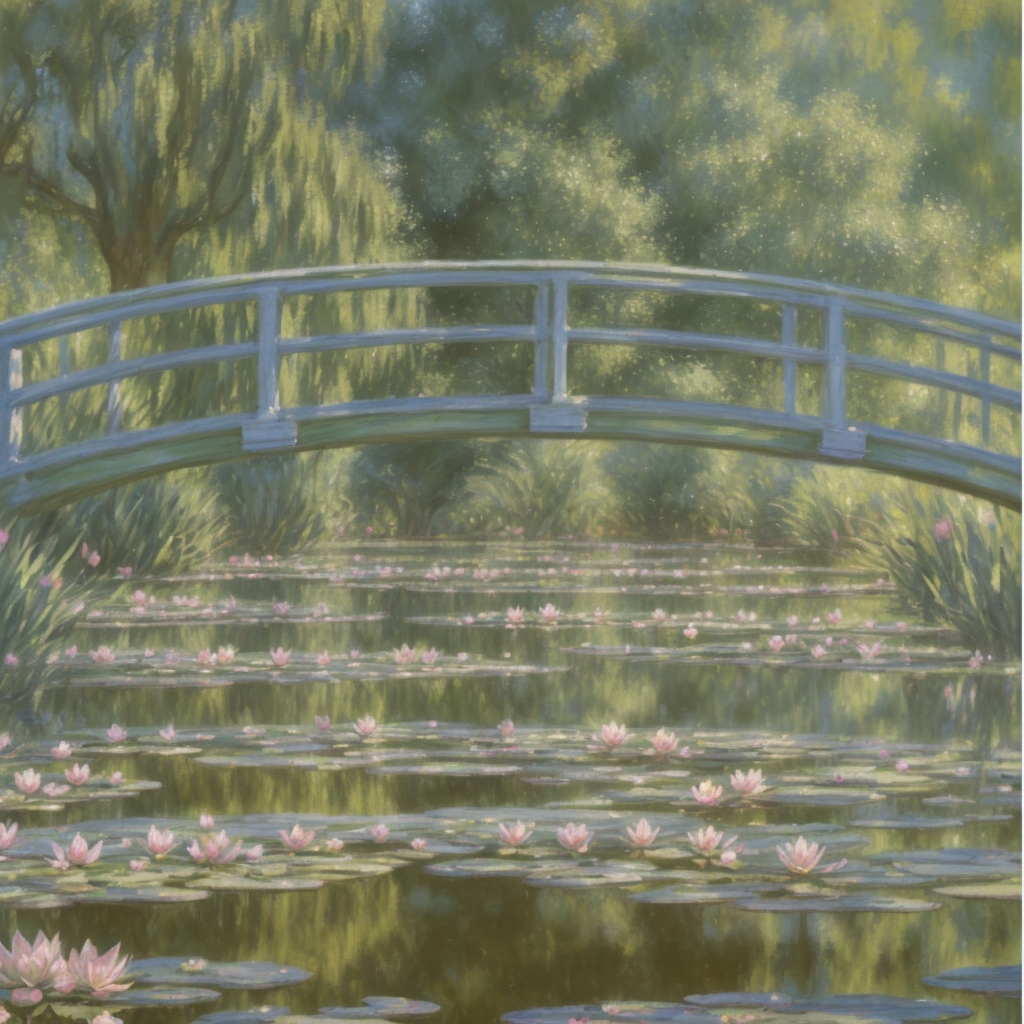
The Water Lily Pond by Claude Monet: A Reflective Oasis
Claude Monet’s “The Water Lily Pond” stands as a timeless masterpiece in the realm of impressionist art, encapsulating the essence of tranquility and capturing the ephemeral beauty of nature. With delicate brushstrokes and a keen eye for light and color, Monet crafted a scene that invites viewers into a serene oasis, where the boundary between reality and dreams blurs.
“The Water Lily Pond,” painted between 1899 and 1900, portrays a secluded corner of Monet’s beloved garden at his home in Giverny, France. The painting depicts a small, arched wooden footbridge spanning across a pond adorned with water lilies in full bloom. The vibrant hues of green foliage and the serene reflections on the water’s surface create a harmonious symphony of color and light.
Monet’s mastery of light is evident in the dappled sunlight filtering through the foliage, casting a gentle glow on the scene below. The soft, blurred edges characteristic of impressionist brushwork imbue the painting with a sense of movement and atmosphere, as if the scene is perpetually in flux.
At the heart of the composition are the water lilies themselves, their delicate petals rendered with intricate detail and subtle gradations of color. Floating serenely on the tranquil surface of the pond, they serve as a focal point of contemplation and reflection, inviting viewers to immerse themselves in the beauty of the natural world.
History:
Claude Monet’s fascination with his water lily pond in Giverny, France, is a testament to his profound connection with nature and his relentless pursuit of capturing its essence on canvas. Over the course of several decades, Monet’s paintings of the water lily pond evolved from mere representations of botanical beauty to transcendent reflections on light, color, and the passage of time.
Early Influences and Inspirations:
Monet’s interest in waterlily paintings can be traced back to his early years as an artist, where he was heavily influenced by the works of the Barbizon School painters and the en plein air techniques of the Impressionists. The Barbizon painters, such as Jean-Baptiste Camille Corot and Charles-François Daubigny, depicted landscapes with a keen attention to natural light and atmosphere, laying the groundwork for Monet’s later explorations.
Additionally, Monet drew inspiration from Japanese woodblock prints, which he avidly collected and displayed in his home. The Japanese aesthetic, characterized by its emphasis on asymmetry, simplicity, and the transient beauty of nature, profoundly influenced Monet’s approach to composition and subject matter.
The Creation of Giverny:
In 1883, Monet settled in the picturesque village of Giverny, located in the Normandy region of France. Enchanted by the rural charm and scenic beauty of the countryside, Monet set about transforming his property into a living work of art. Central to his vision was the creation of a lush garden, complete with a water lily pond, a Japanese footbridge, and an array of exotic plant species.
The water lily pond became the focal point of Monet’s artistic endeavors, providing endless inspiration for his paintings. Surrounded by willow trees, bamboo, and an array of colorful flowers, the pond served as a tranquil oasis where Monet could observe the ever-changing play of light and color throughout the day.
The Evolution of Monet’s Style:
Monet’s early paintings of the water lily pond, dating from the 1890s, are characterized by their vibrant colors and loose, gestural brushwork. These works capture the exuberance of nature in full bloom, with the water lilies depicted in vivid hues against the backdrop of lush foliage.
As Monet continued to explore the theme of the water lily pond, his style underwent a gradual transformation. Influenced by his growing interest in the effects of light and atmosphere, Monet began to experiment with more muted color palettes and softer, more diffuse brushwork.
By the turn of the century, Monet’s paintings had taken on a more abstract quality, with the water lilies dissolving into shimmering pools of color and light. These later works are characterized by their ethereal quality, as Monet sought to capture the fleeting beauty of the natural world in all its transience.
The Series Paintings:
In the final decades of his life, Monet embarked on a series of monumental paintings focused exclusively on the water lily pond. These large-scale canvases, some measuring over six feet in height, are among the most celebrated works of his career.
Painted between 1914 and 1926, these paintings represent the culmination of Monet’s lifelong exploration of the water lily pond theme. Rendered with bold, sweeping brushstrokes and a nuanced understanding of color harmony, these works are a testament to Monet’s mastery of his craft and his unwavering commitment to capturing the essence of nature on canvas.
Legacy and Influence:
Monet’s paintings of the water lily pond have left an indelible mark on the history of art, inspiring generations of artists to explore the intersection of nature, light, and abstraction. His innovative approach to color and form paved the way for the development of modern art movements such as Abstract Expressionism and Color Field painting.
Today, Monet’s water lily paintings are revered as timeless masterpieces, cherished for their beauty, sensitivity, and profound emotional resonance. They continue to captivate audiences around the world, serving as a testament to the enduring power of art to transcend the boundaries of time and space.
Opinions:
“The Water Lily Pond” continues to captivate audiences worldwide, transcending the boundaries of time and space to evoke a sense of serenity and awe. Art critics and scholars praise Monet’s mastery of impressionist technique, noting his ability to convey the fleeting beauty of nature with unparalleled skill.
Many view “The Water Lily Pond” as a meditation on the passage of time and the impermanence of life, symbolized by the ever-changing reflections on the water’s surface. The painting invites contemplation and introspection, encouraging viewers to pause and immerse themselves in the present moment.
For some, “The Water Lily Pond” represents a form of artistic therapy, offering solace and comfort in times of uncertainty and turmoil. Its timeless beauty serves as a reminder of the enduring power of art to uplift the human spirit and instill a sense of wonder in the world around us.
Claude Monet’s “The Water Lily Pond” stands as a testament to the transformative power of art, transcending its status as a mere painting to become a source of inspiration and enlightenment for generations to come. Through his masterful depiction of nature’s beauty, Monet invites us to see the world with fresh eyes and embrace the magic that surrounds us each day.




